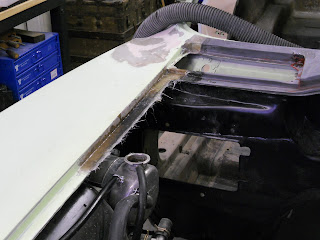We took another hard look at the birdcage and we found one additional area that needs attention. It's the portion of the birdcage that runs along the top of the windshield. There were factory holes here but they looked... irregular. I stuck a burr grinder in each hole then gently pushed it in all directions looking for thinning sheet metal. The burr grinder followed the thinning metal and left behind these tracks. These areas need repair.
I squared up all the areas to simplify making the repair pieces.
16 gauge metal was bent to match the general profile of the birdcage.
This will be cut as needed to fit each repair area.
The pieces were welded in, new holes were drilled, then JB Weld was used to fill the irregularities.
While the JB Weld was hardening I cleaned all the internal surfaces in preparation for paint. I used a length of plastic tubing on the end of the air hose to get deep inside and used the shop vac to catch the debris. There was a bunch of it, mostly sand from the sand blaster.
An hour later the internal surfaces were clean.
This is a product from Eastwood. It's a paint that has a phenolic resin that penetrates, converts and encapsulates any rust on internal surfaces. It also has zinc phosphate that seals internal surfaces to prevent future corrosion. I figured it would work nicely on the birdcage.
It worked great. The nozzle on the end of the hose sprayed the paint very nice.
Be forewarned though. This stuff goes everywhere. It finds all the nooks and crannies and little screw holes too. I like it a lot but be sure to wear full eye protection and old clothes. It's messy! The over spray, runs, and drips you see in this picture were cleaned up afterward.
What about that birdcage repairs from earlier? The JB Weld was ground smooth, the internal surfaces were painted, then a little primer was sprayed on the outside. It's nice and it will last a long, long time.
The body is basically ready for primer now. While we wait for warmer weather we will continue to do odds and ends. The interior floor still needs cleaning. Maybe we will tackle that next. But the next big thing is primer!
Merry Christmas and Happy New Year!






















































